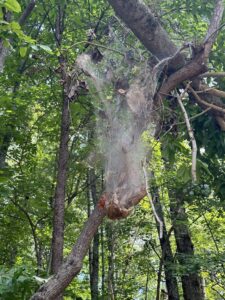By Mathew Parks
Grounds & Landscape Manager
When riding around Big Canoe, there are indicators that fall is almost upon us. The hints of fall color on the trees and the arrival of specific insects can be indicators of that change.
One insect in particular that is prominent in late summer and early fall is fall webworm. They are a native caterpillar that usually shows up in August and September throughout North America and southern Canada. Their main habitat is the hardwood trees where they feed on leaves within their web for a few weeks before turning into a light-colored moth. The preferred hardwood trees of choice in this area are sourwood, cherry, oak, and sweetgum.
The defoliation of the leaves is unsightly but causes no real harm to the host tree since the webworms feed on leaves nearing the end of their annual life cycle rather than on next year’s leaf buds. Big Canoe POA does not treat for fall webworms within the community. Since the damage is more aesthetic than harmful, University of Georgia Extension agents recommended that property owners do nothing. If the decision has been made to get rid of them, chemical control is not effective due to its inability to penetrate the web.
There are other means that can be implemented to remove or treat the insects. If within reach, the best control method is to remove the web and destroy it. This is the most aggressive treatment because this may disfigure the tree. Another option would be to use a pole, stick, or rake to open up the web so birds and other natural predators can take care of the problem. If the webworms can be tolerated for a while, they will eventually leave on their own.
